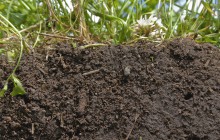Start with Healthy Soil
Soil testing is a key part of a soil health assessment. The Rutgers Soil Testing Laboratory offers a fee-based soil testing service; soil test kits can be ordered online or purchased from a county office of Rutgers Cooperative Extension. A municipality can save money and reduce potential sources of water pollution by using soil test […]

Step 2: Start With Healthy Soil

Purpose
Protect water quality, water supply, and living resources in your local community and throughout the Barnegat Bay watershed by implementing best management practices for healthy and sustainable soils.
Healthy soil is essential not only for growing healthy plants but also for protecting water quality and water supplies throughout the Barnegat Bay watershed. Healthy soil acts like a sponge, capturing rainwater and storing it. In addition to providing a steady source of water to plant roots, the water stored in soil replenishes groundwater supplies used for drinking water and other human uses. Through a series of physical, chemical, and biological processes, healthy soil also helps to remove contaminants from the water.
Created by the Ocean County Soil Conservation District and USDA Natural Resources Conservation Service, the NJ Soil Health Assessment Guide is an easy-to-use tool for assessing soil health. It guides users through a series of observations and simple tests to collect information about various physical, chemical, and biological components of soil health. The assessment results will help you make sustainable soil management decisions.
Soil testing is a key part of a soil health assessment. The Rutgers Soil Testing Laboratory offers a fee-based soil testing service; soil test kits can be ordered online or purchased from a county office of Rutgers Cooperative Extension. A municipality can save money and reduce potential sources of water pollution by using soil test results to make science-based decisions about the use of fertilizers and other amendments.
Equally important, soil test results can be used to select plants that will thrive in the existing soil conditions at a site. Native plants are particularly well-adapted to our native soils. By planting native species that match the site’s soil conditions, you can reduce or even eliminate the need to use fertilizer and pH-adjusting amendments, and also reduce watering needs.
Standard Actions
2A: Assess overall soil health on a landscaped municipal property.

On a landscaped municipal property for which a base map has been prepared (see step 1B), use the NJ Soil Health Assessment Guide to complete a soil health assessment, including a soil test(s). If there are different landscape types (e.g., turf, flower beds, shrubs) on the same property, a separate assessment/soil test should be completed for each type, since recommendations can vary depending on usage. The soil test results from the Rutgers Soil Testing Laboratory include recommendations based on a particular landscape use (see the Rutgers soil test questionnaire for additional guidance).
Using your NJ Soil Health Assessment data sheets, identify potential solutions for any fair to poor score results for each area assessed on the property.
What to submit for Action 2A: A base map showing the soil health assessment/soil testing location(s), completed NJ Soil Health Assessment data sheet(s) with a list of solutions for any fair to poor score results, and a copy of the soil test report(s).
2B: Implement soil health improvement practices to remedy any soil health issues detected during the assessments in 2A.
Apply the solutions you identified during your NJ Soil Health Assessment, along with other soil improvement practices, to remedy any fair to poor score results from the assessments completed in 2A.
For turfgrass areas, refer to the fact sheet Best Practices for Soil Management for Lawns for additional soil improvement recommendations. This fact sheet provides research-based information about best practices for managing sandy soil and soil compaction, two challenges to growing turfgrass in the Barnegat Bay watershed.
After implementing soil health improvement practices, complete another soil health assessment using the NJ Soil Health Assessment Guide, and compare the results to the first assessment. In this way, you can monitor changes in soil health on the property over time.
What to submit for Action 2B: Summary of the soil management practices being implemented to improve soil health at the site. Attach the two Soil Health Data Sheets (one before and one after implementation of the practices) for each landscape type assessed on the property, and compare the results.
Resources
- Jersey-Friendly Yards: Step 2
- Ocean County Soil Conservation District
- Rutgers Soil Testing Laboratory
- NJ Soil Health Assessment Guide
- Best Practices for Soil Management for Lawns

Ready to Submit Step 2?
Upload the Required Documentation to Your Custom Link.
When you enrolled, you received a custom link from us for your action item uploads.
